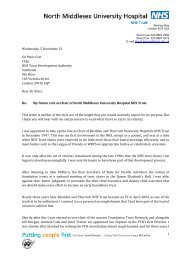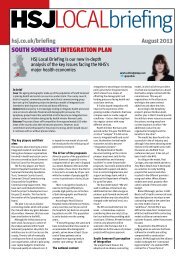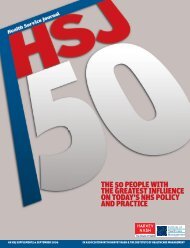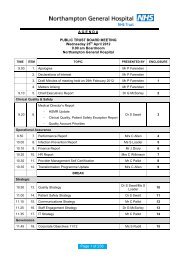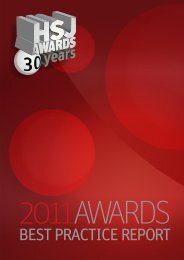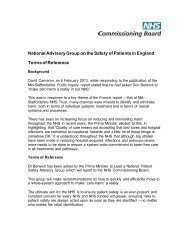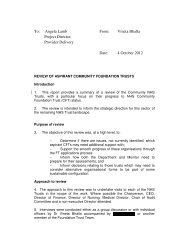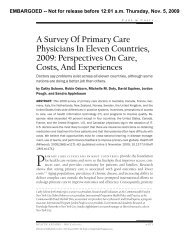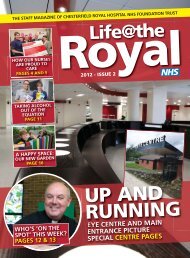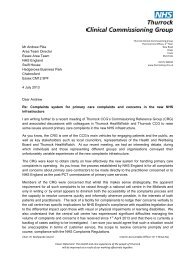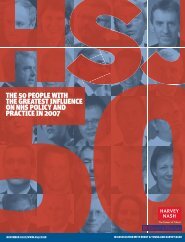HSJ Pathology Supplement - Health Service Journal
HSJ Pathology Supplement - Health Service Journal
HSJ Pathology Supplement - Health Service Journal
- No tags were found...
You also want an ePaper? Increase the reach of your titles
YUMPU automatically turns print PDFs into web optimized ePapers that Google loves.
e better?Joining the debate (from left): Michael Thomas,Jill Rodney, Richard Jones, Hemal Desai androundtable chair Mike Sobanja. Below: AdrianWoolmore (left) and Martin Myersbest, with pathology networks linking intothese. PCT clusters had been asked to comeforward with their ideas.Mr Sobanja questioned what the role ofcommissioners would be in this – did itinvolve dictating to providers what theinfrastructure should look like? ProfessorNewland said commissioners wanted to getas cost effective a service as possible.But Professor Peter Furness, president ofthe Royal College of Pathologists, said therewas a more fundamental question: what wasmeant by pathology? In the Carter report ithad been used to describe an end-to-endservice but it had also been used in adifferent, more narrow sense.“It raises questions about whether we aretalking about a single system delivering theend-to-end service,” he said. He pointed outdemand management was part of this asabout 40 per cent of tests were notnecessary; an organisation working on acost per test basis would have no interest inreducing demand. “We have to have asophisticated view of what we arediscussing,” he said.Richard Jones, chief executive of jointventure GSTS <strong>Pathology</strong>, said there weresignificant benefits in consolidating fromthe laboratory processing point of view,allowing the service to cope with five timesthe volume for just twice the cost.“The challenge is how you do that withoutdestroying the relationship with the wholeclinical service,” he said. “I would claim thatGSTS is part of that solution.” His company– a joint venture – is in partnership with twotrusts in London and involved in the end-toendjourney.“There is also the issue of research anddevelopment which is key to the mission ofour partners but at the same time we want torealise some of the savings.”Cherry pickingThe key challenge was how to deliver theseefficiency savings without losing the clinicalservice proposition. He did not believe apure outsourcing solution – a man and a vancollecting samples – would work andfavoured a partnership which would realisebenefits but preserve clinical quality.Dr Martin Myers, clinical director ofpathology at Lancashire Teaching HospitalsFoundation Trust, pointed to the issue offragmentation of services and cherry pickingin direct access services. For example,changes to one element of the service, suchas direct access pathology, might save moneybut could impact on other parts – such aspathology in secondary care. “If we seepathology as a holistic service with primaryand secondary care delivery there has to be adifferent solution without cherry picking,”he said.Professor Newland said in London theywere clear that clinical aspects of care wereparamount. They were creating a three tierapproach with hubs, spokes and specialistservices but had very good provision ofresearch elements and the clinical servicewhich they did not want to disrupt.“We have taken very much on board theclinical importance of what we are doing,”he said.Mr Sobanja pointed out the importance ofeducating trainee medics to use pathologyservices and the impact this could have onother parts of the workforce. “We are gettingmore and more reports of doctors comingout of medical school not trained how to uselaboratory tests or the pathology service,” hesaid. “If that changes, then the picturechanges.”Mr Sobanja said the Carter report hadbeen produced at the end of a phase whichwas about controlled planning but the NHSwas now entering a phase of providerbusiness; it would be for providers to gettogether and plan. A result of this could bethat “one size did not fit all” in terms ofservices: this meant that London could comeup with a different solution from the one forthe rest of the country. Another option wouldbe to let the market determine the shape ofthe service. “What is the predominant driverat the moment?” he asked.Professor Furness said that the marketwilde FRyhsj.co.uk3 November 2011 <strong>Health</strong> <strong>Service</strong> <strong>Journal</strong> supplement 3



